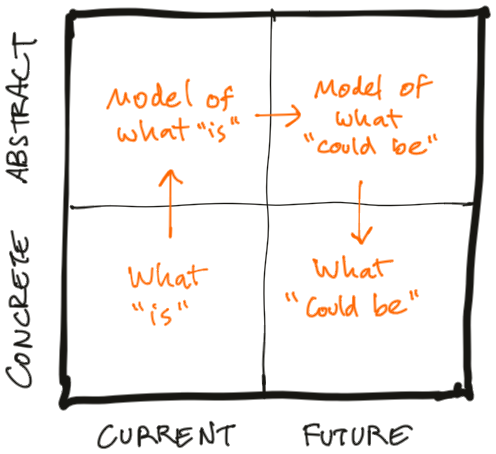In a 2008 paper in ACM’s Interactions, Hugh Dubberly, Shelley Evenson, and Rick Robinson presented the Analysis-Synthesis Bridge Model. This bridge model describes how designers move from the understanding of a problem domain to a proposed solution. It’s laid out along two dimensions:

On the left half, you have the current state you’re addressing, while the right half represents the future (changed) state. (The authors refer to “the solution, preferred future, concept, proposed response, form.”) The bottom row corresponds to tangible conditions in the world that we can observe and interact with, while the top row refers to abstract models of those things. The design process goes from the lower left quadrant — a solid understanding of conditions in the “real” world through abstraction towards a tangible construct that represents a possible future:

While it seems to imply a clear linear progression (something I’ve seldom experienced in real projects), this model corresponds closely to how I design — especially when dealing with complex domains. I can’t sketch tangible structures (e.g., wireframes, sitemaps, etc.) without having 1) a solid understanding of the domain and 2) models that describe it. This requires spending time dealing with abstract models — and abstraction makes people uncomfortable. Clients want to get as quickly as possible to the lower right quadrant, where they can see and interact with things that look like the thing they’ve hired me to produce. (E.g., prototypes.)
But it’s important to acknowledge that when dealing with complex systems, you’re doing clients a disservice by jumping straight to screens. You really must figure out the structures that underlie the domain first, and that requires devising models — both of the current and future states. The bridge model is a useful tool to help explain how the process works and why abstraction is important to a successful outcome.